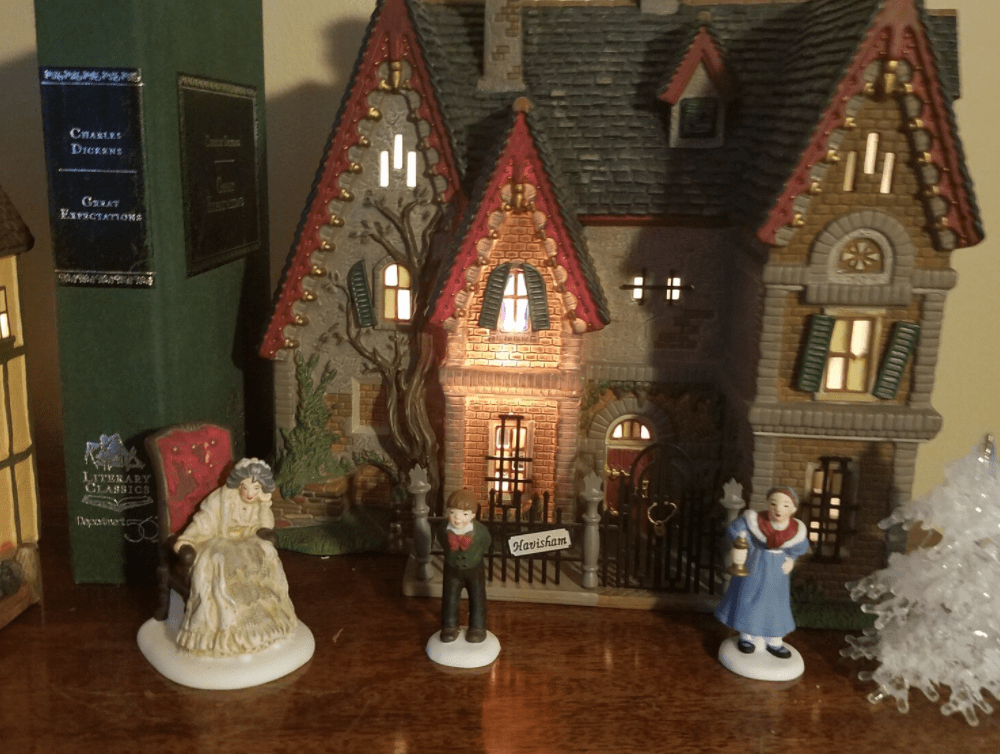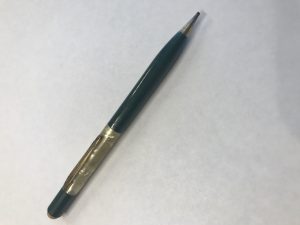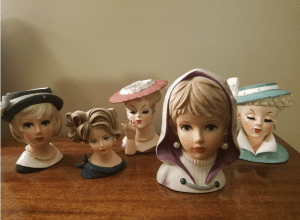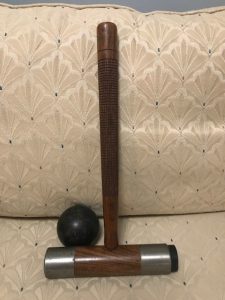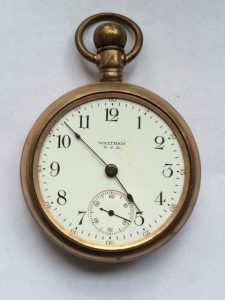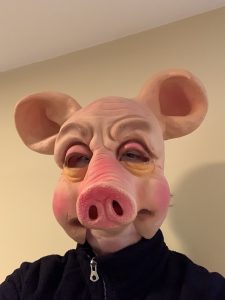An Unexpected Gift
My mom was a generous gift giver. She specialized in matched shirts and ties for the guys, boots and sweaters for us girls, multiple gifts for everyone. And the grandchildren—American Girl dolls with all the trimmings, elaborate Lego sets, the most expensive gifts on their wish lists.
“Lists” is the operative word. She was a generous gift giver who loved nothing more than lists, with specific details of brands, colors and stores. You knew what you would get from Mom. Something really nice from your list.
One Christmas, probably 18 years ago, a good-sized package awaited me under the tree. Usually talented at guessing my presents, I couldn’t fathom what the box tagged “Love, Mom” contained. Nothing I had asked for was big.
It was the first gift I unwrapped. Wrestling it from the packaging, I discerned the words “Dickens Village” and knew it was a building from the series. Not just any building, but the limited edition house of Charles Dickens’ Great Expectations. Complete with Miss Havisham, Pip, and Estella figurines. And a copy of the novel.
The most magical gifts come from the heart–no list can identify them. I was a high school English teacher of literature. I loved to read. I collected books and Dickens Village houses. Mom had spotted the set in the basement of Marshall Fields and looked no further. Her instincts knew I would love it.
She was right. It is my most treasured gift, greater than any of my expectations.
Editor’s Note
This piece was originally published on the Storied Stuff website where you can find many stories about treasured objects from other people’s past.
Last Minute Gift From India
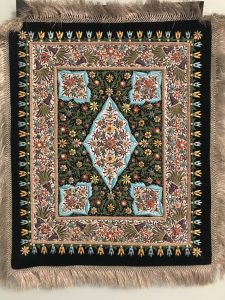 I probably would never have gone to India if it hadn’t been for my great friend and colleague John Dossey.
I probably would never have gone to India if it hadn’t been for my great friend and colleague John Dossey.
John had been given the task, by the U.S. Sub-Commission on Religion and Culture, of selecting four U.S. mathematics educators to speak at a World Mathematics Conference in Goa, India. I quickly accepted when John asked me to participate.
Upon arrival, on October 30, 1989, my wife Harriet and I were met at the airport in New Delhi by a representative of the U.S. Sub-Commission.
We had a strange mixture of emotions when he handed us a large bag of paper money (rupees) and told us that this was for our expenses, with any money left over to be spent in India.
When the wonderful nine-day mathematics conference ended, Harriet and I were in India for an extra week, and enjoyed the Taj Mahal, a touch of Ghandi, and some wandering sacred cows. We even endured a night with me sick in a third rate hotel in Jaiper, the Pink City.
But that’s another story.
On our last day, running out of the money and almost ready to board our flight home, we saw this special wall hanging in a little shop. We both loved it, and found that after we bought this last-minute gift, we would have 109 Rupees left, equal to about $1.50.
Harriet and I dedicated the wall hanging to John Dossey and whenever we looked at it we thought of him and that wonderful trip to India.
First Pitch Baseball
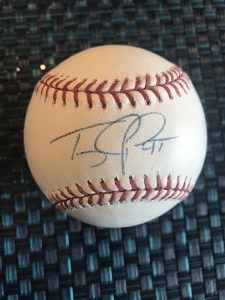 What a day! Wrigley Field, July 24, 2011. My wife Harriet, all my kids and grandkids, and several relatives and friends were there.
What a day! Wrigley Field, July 24, 2011. My wife Harriet, all my kids and grandkids, and several relatives and friends were there.
As the stadium announcer said “Phares O’Daffer will throw out the first pitch!,” my name appeared on the marquee.
A sign, “My grandpa only pitches strikes,” appeared in my grandkids section, and I heard some person ask “Who is that guy?”
It seemed like 40,000 people waited in anticipation as Cubs rookie Tony Campana prepared to catch my pitch.
At that moment, I wasn’t 77 year-old senior Phares, but rather 18 year-old Ike, pitching for the Cubs.
I threw that ball about as hard as I could, and it went to Tony on the fly. The crowd said “oooh,” and so did I, as he had to make a quick leap to the right and high to catch it.
Good old Tony. The deed was done, and I didn’t roll it in there.
Tony shook my hand, and autographed the ball I had thrown. At 5’8”, one of the shortest players in baseball, he had performed an amazing feat to catch my ball, and I will be eternally grateful.
As I walked back to my seat, a lady said “You must be somebody important to throw out the first pitch. Would you autograph my daughter’s baseball?”
Knowing full well that all it took was several bucks at an auction to get to throw that pitch, I signed her ball “Ike Lefty O’Daffer,” and smiled like a pro.
My Favorite Autograph
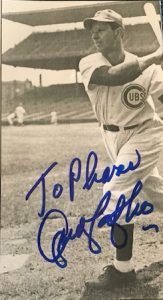 Fourteen years old and having never been over 50 miles from home, I went to Wrigley Field on July 1, 1948 with my best friend Terry and his parents to see a Chicago Cubs baseball game.
Fourteen years old and having never been over 50 miles from home, I went to Wrigley Field on July 1, 1948 with my best friend Terry and his parents to see a Chicago Cubs baseball game.
They were gung-ho Cardinals fans, and I a tepid Cubs fan. In the seventh inning, with the Cardinals leading 3-1, it looked pretty grim.
Then, with two out and two on, my favorite Cubs player, Andy Pafko, came up to bat. Without an ounce of doubt, he swung and hit that ball way over the centerfield fence!
The Cubs took a 4-3 lead, and never gave it up.
I guess the reason I cherish this game so much is that it was the catalyst for my 80 years as a staunch Cubs fan. The Cubs never stopped trying, and you could always expect a home run in the bottom of the seventh.
And even though the Cardinals won several of the Cubs-Cardinals games I’ve gone to with Terry, I’ve never let him forget that amazing July afternoon at Wrigley field in 1948.
In 2011, My son-in-law’s dad Chuck was on a senior citizens’ bus trip and found himself sitting beside Andy Pafko. He told Andy my story of the game, and 90-year old Andy produced a 4×6 photo, addressed it to me, and signed it. When Chuck told me what Andy said about that game, I couldn’t help but feel that Andy Pafko and I had been partners “in spirit” in my “game of the century.”
How Can a Pencil Be So Important?
Back in 1960, working in the Burris Laboratory School at Ball State University—and before the age of the word processor on a computer–I was using this little Scheaffer lead pencil a lot. If I needed to write something, I would get my trusty yellow legal pad, and have at it. I liked the idea that if I made a mistake, I could just erase it and start again.
Through an amazing series of events, I had an opportunity to later move to California and co-author a 3-6 grade elementary school mathematics textbook series. My Sheaffer lead pencil went with me.
For two years I used that dear little pencil to write pages and pages of manuscript on my yellow pad. Yes, I erased a lot, and started again. But somehow, I had confidence in that pencil. Not that it provided exciting ideas for those books, but it hung in there, as I did, and my part of four books (1,628 text pages) was born.
These books, that ushered in some non-traditional ideas for teaching kids mathematics, were each used by 1.5 million children in North and South America, and went on to form the basis for a K-8 Series that was used at one time in over one third of the elementary school classrooms in the United States.
So that Scheaffer pencil, finally succumbing to the word processor on my 1973 computer, did its job… and what a job it was!
Gray Reunion Meeting Minutes
 Ninety-seven years ago, my great-grandparents Emmett and Alice Gray started a reunion in Weldon, Illinois, to bring their five children and other relatives together every August.
Ninety-seven years ago, my great-grandparents Emmett and Alice Gray started a reunion in Weldon, Illinois, to bring their five children and other relatives together every August.
But it wasn’t just a social gathering. They wrote a charter, had members and officers, and conducted meetings governed by Roberts Rules of Order.
These binders, which I have because I’m the current Secretary-Treasurer of The Gray Reunion, contain the minutes of those meetings. Until the 1990s, most were hand-written by various women of The Gray. Having beautiful handwriting isn’t a requirement for the office (nor is being a woman), but the sweeping, precise cursive strokes preserved in these minutes is rarely seen anymore.
Last year, as research for a book I’m writing, I read all the minutes and put them in these binders, along with the original cover made by someone long ago. For the most part, the details are similar — who was there, where the reunion was held, how much money is in the kitty, who was elected to office, committee tasks, where the reunion will be held the following year, and who did what for entertainment.
In 1969, reunion members started sharing the highlights of their year. These accounts are also similar. Because life changes, but often not in very dramatic ways. Every year, people vacation at the same places, watch their kids play the same sports, have the same jobs, do the same hobbies, and follow the same sports teams. They get married, have babies, those babies grow up, and the cycle starts again.
The binders also include poems written by my Grandma Ruby (The Gray’s official poet laureate), reunion trivia, essays, newspaper clippings, and other things shared for entertainment. There are also tributes to family members who have died and historical information about Emmett and Alice’s life.
I’m guessing not many families have written legacies like this. And because the books change keepers each time a new Secretary-Treasurer takes office, they may be in danger of being lost some day.
All the more reason to start a digital archive. Do I have a motion for this?
Editor’s Note
This piece was originally published on the Storied Stuff website where you can find many stories about treasured objects from other people’s past.
Purple Lady
They were weird but fascinating. Disembodied female heads from the 1930’s/40’s with holes in their noggins for flowers. I bought one at an antique shop for my art deco bathroom. Then, I started collecting them—stylish white ladies with upswept ceramic hair, dangly faux pearl earrings and necklaces, elaborate hats, stiff “hair” eyelashes, red lips and manicured nails. One looked suspiciously like Jackie O.
Small head vases ran $60-85 from a knowledgeable dealer. Larger, unusual ones in great condition–possessing both earrings, say—sold for hundreds. My most expensive value was $125. Until one summer at Sandwich Antiques Fair….
My friend Janine summoned me: “Hey Suz, come look at this,” holding up a lovely lady with an elegant white and purple cape draped over her hair and white turtleneck, and two pearl earrings.
Her only flaw was a chip at the vase opening. She was unique, seemed like the real deal–not a reproduction. “I need another head vase like I need a hole in MY head,” I replied. We moved on. But at closing time when we walked by the booth, Purple Lady waited patiently. I got her for a mere $22.
“Antiques Roadshow” inspired, I did my research. I discovered “Rose,” a bonified head vase expert, and her extensive website. Though Purple Lady was not catalogued, I found others who could’ve been her sisters. I contacted “Rose,” sent pictures, and ultimately found the encircled “R” manufacturer’s marking. Authentic.
Weeks later, “Rose” sent the big reveal. My $22 investment was worth $450! She offered to purchase her.
The thrill of discovery. A great story. Priceless.
Editor’s Note
This piece was originally published on the Storied Stuff website where you can find many stories about treasured objects from other people’s past.
My Dad’s Croquet Mallet
At my dad’s funeral, in March 1950, as the shock of the farm accident that took his life was waning, people talked about how much he loved to play croquet.
No, not the little league game of lawn croquet, but the major league game of court croquet!
The court, which was surrounded by a 6-inch high concrete wall, had a hard, very smooth clay surface, covered with a thin layer of sand, with 1-inch diameter iron arches.
Using a decorative short-handled mallet and a hard rubber ball that barely went through the arch, this was a game of true shots and creative skill.
Even though money from farming was short, my dad somehow found a way to pay someone to make him a beautiful, high quality, mallet. It was his symbol of the exquisitness of the game.
Croquet tournaments were becoming popular around the Midwest, and my dad had always talked about him and me playing in one.
Sadly, my dad’s bucket list wouldn’t be completed. When I started to play again, I wondered if I should use his mallet, instead of my cheaper, youth mallet. But somehow, it didn’t seem right.
But over a year after he died, in August 1951, I decided to honor my dad by using his mallet in a croquet tournament in Clinton, Illinois.
I couldn’t do anything wrong. Every shot was perfect. I won the tournament going away!
It seemed like my dad was hitting the shots, not me. And maybe he was.
Editor’s Note
This piece was originally published on the Storied Stuff website where you can find many stories about treasured objects from other people’s past.
A Treasured Watch
For 70 years, I’ve kept an old “gold” pocket watch in a red leather box in my dresser. It has survived 16 moves. I always know where it is, but rarely look at it.
Recently, a friend mentioned that he had restored an old pocket watch he owned, and I wondered if I should do the same.
So I forthwith took my watch to the watch expert and asked him, with positive anticipation, if it was worth restoring.
“Well,” he said, after giving the watch only a tad more than a cursory glance, “I wouldn’t mess with it. Pocket watches like this are a dime a dozen.”
On the way home, the more I thought about the watch, the angrier I got. A dime a dozen, indeed! He didn’t really know anything about my watch, and strangely, I had ignored what I knew about it too. I realized again how valuable my watch really was.
The watch belonged to my father Ray Odaffer. It was bequeathed to me after he was caught in a post-hole digger and killed in a farm accident when he was 49 years old and I was 15 years old.
My dad liked this watch and always carried it (as on the day of his accident) in the watch pocket of his overalls. Perhaps watches like these are a dime a dozen, but my watch is priceless.
I shouldn’t have needed a watch expert to tell me that.
Editor’s Note
This piece was originally published on the Storied Stuff website where you can find many stories about treasured objects from other people’s past.
Piggy Mask
I can’t remember why I bought this rubber piggy mask 28 years ago. I think I wanted to use it to joke around with my family and scare people when we were together at my parents’ house on Lake Bloomington in Central Illinois.
You know, like putting on the piggy mask and lying down in someone’s bed or knocking on the front door.
After I pranked my brother-in-law Bruce and we had a good laugh, he put on the mask and snuck up on his four-year-old daughter Jordan.
“Oink, oink,” he said, his voice muffled by the plastic mask.
Jordan took one look at him and let out a piercing, terrified scream and went running down the stairs looking for her mother.
Startled by her reaction, Bruce took off the mask and tried to show Jordan that it was really only him. But she wouldn’t have any of it. She was really scared.
After that, I put the piggy mask away for a while.
The last person to wear it was my husband Richard, who decided one Halloween to answer the door with it on to scare trick-or-treaters. A few of them screamed. But none ran away.
Editor’s Note
This piece was originally published on the Storied Stuff website where you can find many stories about treasured objects from other people’s past.


